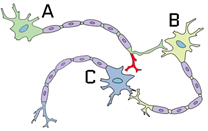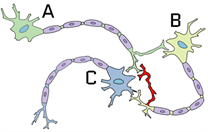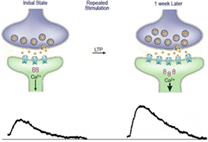An investigation into the common mechanism(s) between disorders which display synesthesia-like symptoms
C. Green, A. Berrill, B. Catt, J. Lindsay, L. McCluskey, K. Withers

Figure 1 - The pruning model
The term synesthesia comes from Greek terms for syn (together) and aesthesis (perception) meaning ‘joined’ perception.
There are as many as 19 different types, the most common being grapheme-colour synesthesia, where numbers and letters are perceived or seen as having different colours.
There are two proposed models for the neurological basis of synesthesia, known as the Pruning and Disinhibition models.
The pruning model suggests that the pruning - or removal - of neurons which would normally occur in cognitive development, does not occur.
This results in abnormal connections between different regions of the brain, for example colour-vision and language processing.
In contrast, the disinhibition model suggests that it is not the abnormal presence of connections; rather it is the abnormal use of the existing connections.

Figure 2 - The disinhibition model

Figure 3 - Visual effects of synesthesia and dyslexia
The project explored beyond the neurological models, and look into the molecular basis of synesthesia. There are many disorders that show synesthesia-like symptoms such as autism, schizophrenia, absolute pitch and dyslexia. Genes associated with dyslexia are in the same chromosomal regions as those that are associated with synesthesia. The effects of both conditions are displayed in Figure 3.
A list of genes was compiled that had been implicated in more than one disease in which 126 were found, and then narrowed it down to genes located in regions linked to synesthesia.
VisANT and Reactome analysis was then carried out to identify pathways within the body these genes were linked with.
This led to the proposal of a new model – The long term potentiation model, suggesting there is a constant strengthening of synapses that produce a long-lasting increase in signal transmission between two neurons.

Figure 4 - Long term potentiation